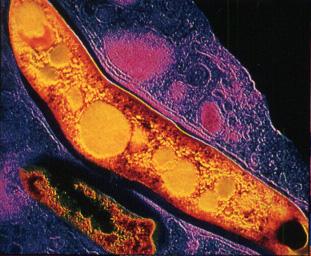Mycobacterium
Материал из Поле цифровой дидактики
| Описание микроба | Род бактерий семейства Mycobacteriaceae, некоторые представители которого (например, M. tuberculosis, M. leprae) патогенны для млекопитающих.
Греческий префикс «myco-» (от др.-греч. μύκης ‘гриб’) присвоен данному таксону бактерий из-за способности многих представителей рода образовывать грибоподобный мицелий на одной из стадий развития (обычно в благоприятных условиях) |
|---|---|
| Верхний таксон | Bacteria; Actinobacteria; Actinobacteria (class); Actinobacteridae; Actinomycetales; Corynebacterineae; Mycobacteriaceae; Mycobacterium; Mycobacterium tuberculosis complex |
| Species - виды | Mycobacterium tuberculosis (возбудитель туберкулёза), M. leprae (возбудитель проказы) |
| Genome Structure= структура генома | Both the genomes of Mycobacterium tuberculosis and Mycobacterium leprae have been sequenced with hopes of gaining further understanding of how to defeat the infamously successful pathogens. The genome of M. tuberculosis is 4,411,522 base pairs long with 3,924 predicted protein-coding sequences, and a relatively high G+C content of 65.6%. At 4.4 Mbp, M. tuberculosis is one of the largest known bacterial genomes, coming in just short of E. coli, and a distant third to Streptomyces coelicolor. |
| Cell Structure - клеточная структура | Mycobacteria are rod-shaped, Gram-positive aerobes, or facultative anaerobes. As deduced from its genome, M. tuberculosis has the potential to manufacture all of the machinery necessary to synthesize all of its essential vitamins, amino acids, and enzyme co-factors. On the other hand, the inability to culture M. leprae, suggests that it has lost many of its metabolic capabilities, and is now an obligate parasite, dependent on its host for most of its nutritional needs. This goes in accordance with its severely degenerated genome. M. tuberculosis has an unusual cell wall, with an additional layer beyond the peptodiglycan layer, which is rich in unusual lipids, glycolipids, and polysaccharides. |
| Ecology= экология обитания | It is thought that the more well-known infectious agents such as M. tuberculosis and M. leprae are evolved from a soil bacterium. More specifically, M. tuberculosis arose from a soil bacterium that evolved to infect cows, and then made the jump to humans about the time of animal domestication about 10,000 years ago. M. tuberculosis and M. leprae both grow remarkably slow for bacteria. M. tuberculosis doubles its population every 18-24 hours, while M. leprae doubles its population about every 14 days. This extremely long generation time probably contributes to the chronic nature of both diseases. |
Основные принципы лечения : • Своевременное начало лечения • Индивидуализированный подбор схемы химиотерапии • Длительность и непрерывность • Этиотропная химиотерапия (оптимальная комбинация лекарственных препаратов с бактериостатическим и бактерицидным эффектом) • Применение комплекса лечебных мероприятий • Контролируемое лечение • Преемственность
https://microbewiki.kenyon.edu/index.php/Mycobacterium

